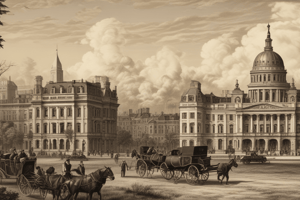Podcast
Questions and Answers
What characterized the economy of the Gilded Age?
What characterized the economy of the Gilded Age?
- Slow economic growth
- Rapid economic growth and social change (correct)
- Stagnation and decline
- Economic recession
Why did the building of a railroad network lead to industrial growth?
Why did the building of a railroad network lead to industrial growth?
Raw materials and finished products were shipped quickly and cheaply.
When was the Transcontinental Railroad completed?
When was the Transcontinental Railroad completed?
1869
What was a characteristic of a corporation?
What was a characteristic of a corporation?
What was one major effect of industrialization on American society?
What was one major effect of industrialization on American society?
How did the US population change during the Gilded Age?
How did the US population change during the Gilded Age?
How did railroad expansion affect the growth of major urban centers?
How did railroad expansion affect the growth of major urban centers?
What meant the development of a system of mass production in manufacturing?
What meant the development of a system of mass production in manufacturing?
What contributed to population growth during the Gilded Age?
What contributed to population growth during the Gilded Age?
The expansion of railways meant manufacturers could ship goods cheaply.
The expansion of railways meant manufacturers could ship goods cheaply.
The building of railroads did not change the environment of the West.
The building of railroads did not change the environment of the West.
Study Notes
Economic Landscape of the Gilded Age
- Characterized by rapid economic growth and significant social change.
- The United States experienced transformative shifts in industry and society during this period.
Impact of Railroads on Industrial Growth
- Expansion of railroad networks enabled efficient and cost-effective shipping of raw materials and finished products.
- The Transcontinental Railroad was a pivotal development, completed in 1869, connecting the east and west coasts.
Corporate Development
- Growth in business operations led to the emergence of corporations as a new organizational structure.
- Corporations allowed for the pooling of capital and resources, fostering larger business ventures.
Population Dynamics
- U.S. population surged from nearly 40 million in 1870 to nearly 80 million by 1900, reflecting significant demographic changes.
- Immigration played a key role in this population growth, bringing diverse workers to the country.
Urbanization and Transportation
- Railroad expansion facilitated easier travel to and from urban centers, encouraging urban growth and development.
- Major cities became hubs of economic activity due to improved transportation networks.
Advances in Manufacturing
- Introduction of mass production techniques, where machines rapidly produced large quantities of products, revolutionized manufacturing.
- Increased production capabilities contributed to the availability of a wider range of goods.
Environmental Effects of Railroads
- The expansion of railways had environmental impacts, altering the landscape and ecology of the western United States.
- Manufacturers benefited from the railroads, as they could ship goods more cheaply and efficiently, leading to increased industrial output.
Studying That Suits You
Use AI to generate personalized quizzes and flashcards to suit your learning preferences.
Description
Explore the dynamic economic landscape of the Gilded Age, characterized by tremendous growth and social change. Discover the transformative influence of railroads, the rise of corporations, and significant demographic shifts due to immigration. This quiz highlights how these factors shaped the United States between 1870 and 1900.




